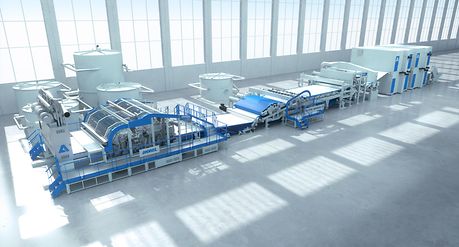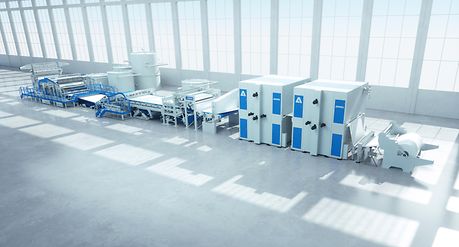"HOWEVER, THE BAN ON SINGLE USE PLASTICS IS GOING TO SEE A MAJOR CHANGE IN THE WAY WIPES ARE MADE!"
ALEXANDRE BUTTÉ
The pressure on eliminating plastics from the supply chain is coming from a variety of sources; first and most urgent is the stricter regulations being put in place by governments – for instance the EU Commission states that plastic items make up for 80-85% of litter found on beaches and wet wipes and hygiene products are firmly on the list of the ban of Single Use Plastics (SUP) directive. Added pressure is also growing from the major brands, keen to be seen to be working on the problem, and finally there is the ever-aware consumer, who is looking more and more at the labels on products and what they are made of.
Henning Vomhof, Sales Manager, Wetlaid, ANDRITZ Nonwoven, says, “It is clear that our customers are taking these moves on plastics in wipes products very seriously, and we have received a number of orders now for lines that are capable of producing bio-wipes.”
Not the only organisation that raises the pressure to avoid or minimize micro pastics: The European Union
Alexandre Butté, Business Development Director, ANDRITZ Nonwoven, says, “Actually at ANDRITZ we have already had over 20 years experience in producing technology for wipes production using raw materials such as bamboo and cotton. As demand for wipes has increased, and they have become a commodity product, it was much less expensive to use polyester and polypropylene.
“However, the ban on single use plastics is going to see a major change in the way wipes are made, and producers are going to have to look closely at changing their product portfolios and the raw material they are using. There are currently hundreds of lines producing personal care wipes using a combination of viscose, polyester and polypropylene, which will be threatened by the SUP.”
ALEXANDRE BUTTÉ
The world of wipes production is certainly a complex one when it comes to raw material price volatility and varying demand. “We have many customers who are running their lines with 100% viscose as a raw material,” continues Butté. “During the COVID crisis the price of viscose has been lower than usual, but this will not last for long, and prices will rise as textile demand increases once again.
“Now is the time for nonwovens producers involved in wipes production to formulate a new strategy in how to remove all plastics from their own supply chains, as well as look at the best natural raw materials to be used for their processes.”
The wipes industry now finds itself in the perfect storm of having to use a more expensive raw material or process at the same time as demand continues to increase for a more environmentally friendly product. In the meantime, ANDRITZ has been working hard at finding ways for nonwovens wipes producers to weather this storm, and now has a raft of new technology available to help nonwovens wipe producers to make the shift to producing bio-wipes.
“We have been firmly working on the concept of “economy and ecology” going hand in hand and in the same direction,” says Butté. “Added to this we have also worked hard on making sure that the end quality of the product is comparable with the best wipes on the market.”
The solutions ANDRITZ has been able to develop come from a deep history in providing technology for wood-based industries, for instance pulp and paper manufacturing. This extensive knowledge has now resulted in ANDRITZ being able to supply new technologies in nonwoven lines for the production of wipes on spunlace, WetlaceTM and the next generation in production technologies a combination of both – an inline drylaid and wetlaid webforming process.
ANDRITZ Spunlace lines have been designed for producing high capacities of up to 25,000 tonnes per year with the emphasis on low energy consumption. For bio-wipes, the lines will handle viscose, bamboo, hemp or cotton as raw materials and will create top performing products with all the attributes of softness, drape, comfort and high strength. An added advantage of the spunlace nonwoven is that no chemicals are needed in the process.
Viscose is used a lot in the spunlace process, mainly because of the excellent softness, but other natural fibers are coming in and there is a growing trend to use hemp and flax.
“There is a lot of attention beginning to center on hemp as a raw material, particularly in North America where legislation changes on medical CBD have recently come into place. This means that a lot of hemp is now grown, however it is only the leaves that are needed, and not the stems and stalks. This brings an added advantage from an environmental angle as the raw material is coming from what would normally be a waste product.”
ANDRITZ has also responded to the call for biodegradable and dispersible wipes in the premium section of the market with its WetlaceTM technology. This proven process is ideal for producing premium products from 100% natural or renewable raw materials, again without the use of chemical binders. The latest in ranges of moist toilet tissue wipes (MTT) are made from fully biodegradable fibers, have good strength properties while in use, and disperse quickly in municipal sewage systems.
“In a commoditized market, the raw material cost becomes a major issue,” says Vomhof. “In nonwovens the raw material cost represents 70% of the total end product cost. The real advantage of using the WetlaceTM process is that it allows the producer to use the least expensive raw material available, wood pulp.”
An example for more plastic-reduced and plastic-free end products: ANDRITZ Wetlace technology
An essential process step in bio-wipes production – the combination of inline drylaid and wetlaid webforming.
The new and rising star in the production of bio-wipes is the development by ANDRITZ of inline drylaid and wetlaid webforming processes. The fully engineered production lines combine the benefits of WetlaceTM and drylaid technologies to provide a solution for a new generation of biodegradable wipes. The technology has been exhaustively tried and tested on the frontline of nonwoven wet wipes products and has passed the test of the most decerning of end-users.
The process allows the use of wood-pulp, which has a positive impact on raw material costs, at the same time as producing environmentally friendly, completely plastic-free products that are of the highest quality. This represents fully the aim of ANDRITZ in creating a way for ecology and economy to work together in one process.
“With the inline drylaid and wetlaid webforming process, we have developed a solution in both an economic and environment-friendly way – the best of both worlds,” says Butté. “Ecology and Economy are not fighting anymore.”
There is a tendency to believe that using wood pulp as a raw material in nonwovens wipe production results in a lower quality product, including a product that is stiff and harsh, and also prone to linting. “With the combination of inline drylaid and wetlaid webforming, and after vigorous R&D, we have completely eliminated all of those potential weaknesses,” says Vomhof.
ANDRITZ neXline wetlace™ CP
ANDRITZ neXline wetlace™ CP
ANDRITZ has been working on the the new process for a number of years now with development being firmly linked to the probability of a single use plastic ban in the near future. R&D work was carried out in ANDRITZ own laboratories and pilot machines and then crucially the products were trialed at leading nonwoven wipes converters and finally in the marketplace.
“We partnered with one of the leading suppliers of wipes to the industry in the R&D phase of the inline drylaid and wetlaid process development,” says Butté. “This was paramount to achieve a successful result as the product quality had to be comparable to the best products on the market. Obviously, touch and feel is everything when it comes to quality in wipes. Step by step we eliminated all the challenges associated with using pulp, including stiffness, harshness, wet strength, bulk and linting.
“After a period of five R&D cycles, all in all lasting around eighteen months, a perfect, spunlace-like product was achieved that was fully biodegradable,” says Wolfgang Schumacher, Head of Sales, Wetlaid, at ANDRITZ Nonwoven
WOLFGANG SCHUMACHER






